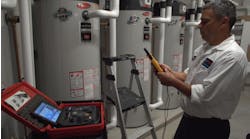It is not uncommon for a facility to be impacted by foul smells stemming from sewer odors. Typically found in parts of the building that are not in everyday use, odor problems pose a significant threat to any office, that can quickly turn off potential clients and more importantly, drive away current employees.
Related: How to Get the Most out of Your Air Filtration System
The causes for particular odors depend on the situation. See the most commonly asked questions below:
What Is Sewer Gas?
Sewer gas is a mixture of inorganic gases that contain such compounds as hydrogen sulfide, ammonia, carbon dioxide, methane, nitrogen and hydrogen.
While these substances may not mean much to most people, should you come into direct contact with the gases released by this combination of ingredients, the result could be serious injury to your respiratory system or even death. However, as we will discuss, the sewer gas odors that are released into buildings are generally not harmful to occupants.
Why Do Sewer Odors Smell So Bad?
First, we should point out that the combination of these ingredients can and do cause odors, but at their lowest concentrations, they may not be detectable by the human nose. And some of these ingredients, even though they can be harmful to one’s health, are actually odorless. So as to the chief cause of the odors, it is the hydrogen sulfide and the ammonia that are the key culprits.
Related: Top 5 Tips to Combat Facility Odors
How Do Sewer Odor Gasses Get Inside a Building?
The most common way these gases can get into most homes or buildings, especially those built since the 1950s, is through the plumbing. And in most cases, these gases escape through the floor drains found in restrooms, basements, janitorial closets, and so on. Following are the most common routes through which these gases enter:
- A blocked vent. Every facility has a vent system specifically for the plumbing in the building. Its purpose is to equalize the atmospheric pressure caused by wastewater running through the system and to allow sewer odors to escape. If this venting is somehow blocked, odors can’t be released outside and can build up inside the building.
- A damaged drain line. In some cases, the drain line may have developed a crack or may be broken. This can cause sewage to be released right under the facility instead of being carried away. While a broken or damaged drain line is generally rare, it can happen with age or after a catastrophic event such as an earthquake.
- A dry trap. This is the most common cause of sewer odors. A trap is a very simple device that does a great deal of work. It is made from a U-shaped pipe or tubing, which connects on one end to the drain—such as a floor drain or the drain of a restroom fixture—and on the other end to the line going to the sewer. The trap collects and holds a small amount of wastewater, and it is this wastewater that prevents sewer gases from coming through the drain and releasing odors into the building.
Are These Gases and Sewer Odors Harmful?
As we previously mentioned, should you inhale these gases and the substances that make up these gases right from the source (i.e., the sewer), yes, they can be harmful. Hydrogen sulfide is toxic. It can have a depressant effect on the human nervous system.
Read also: Is Your HVAC System Spreading Thirdhand Smoke?
However, under most circumstances, the odors that are released through a floor drain, for instance, are more bothersome than harmful. However, they should not be ignored. When detected, steps should be taken to eliminate them.
What Should We Do if We Detect Sewer Odors in Our Building?
Take the easiest and least expensive steps first. If the odors are coming from a floor drain or a rarely used sink, for instance, pour two cups of pure tap water down the drain and then wait a day or two. If the odors dissipate, that indicates that the trap had gone dry and pouring the water down the drain blocked the odors.
But this is only a temporary fix. The trap will likely go dry again very soon, maybe even within a few days.
If a trap liquid does not solve the problem, remove the grating over the problem drain, if possible, and clean the drain. This may remove the germs and bacteria causing the odor. After cleaning, use a disinfectant as a final step in the cleanup operation.
[Trending: The Cleaning RFP Process: Obtaining a Tailored Workplace Solution]
After taking these steps, if sewer odors still persist, a plumber should be called in to investigate. A crack may have developed in the drain line, and this can be repaired only by a plumbing professional.
Article was submitted by Waterless Co., and is originally posted on its site. For information about sewer odors and solutions, please visit Waterless Co.
Two handpicked articles to read next:

